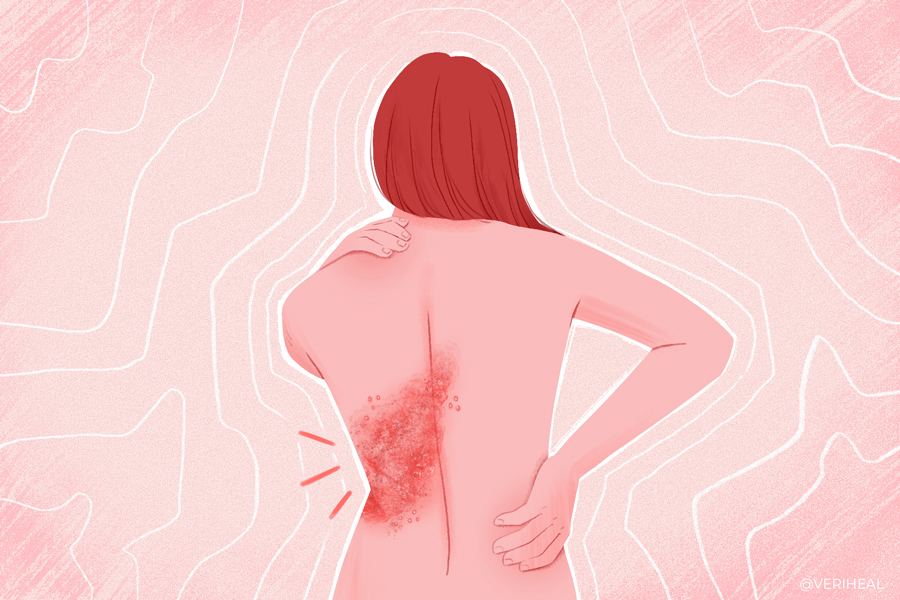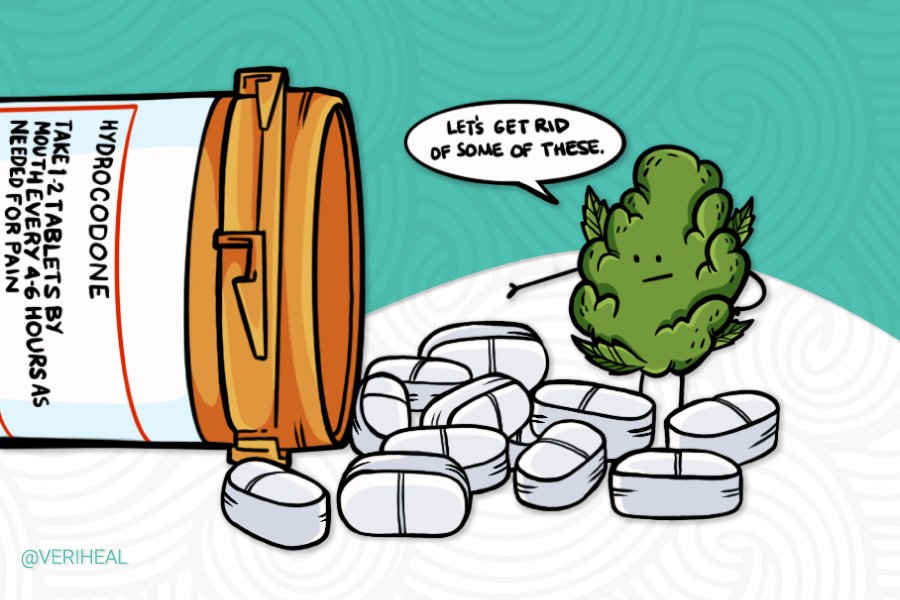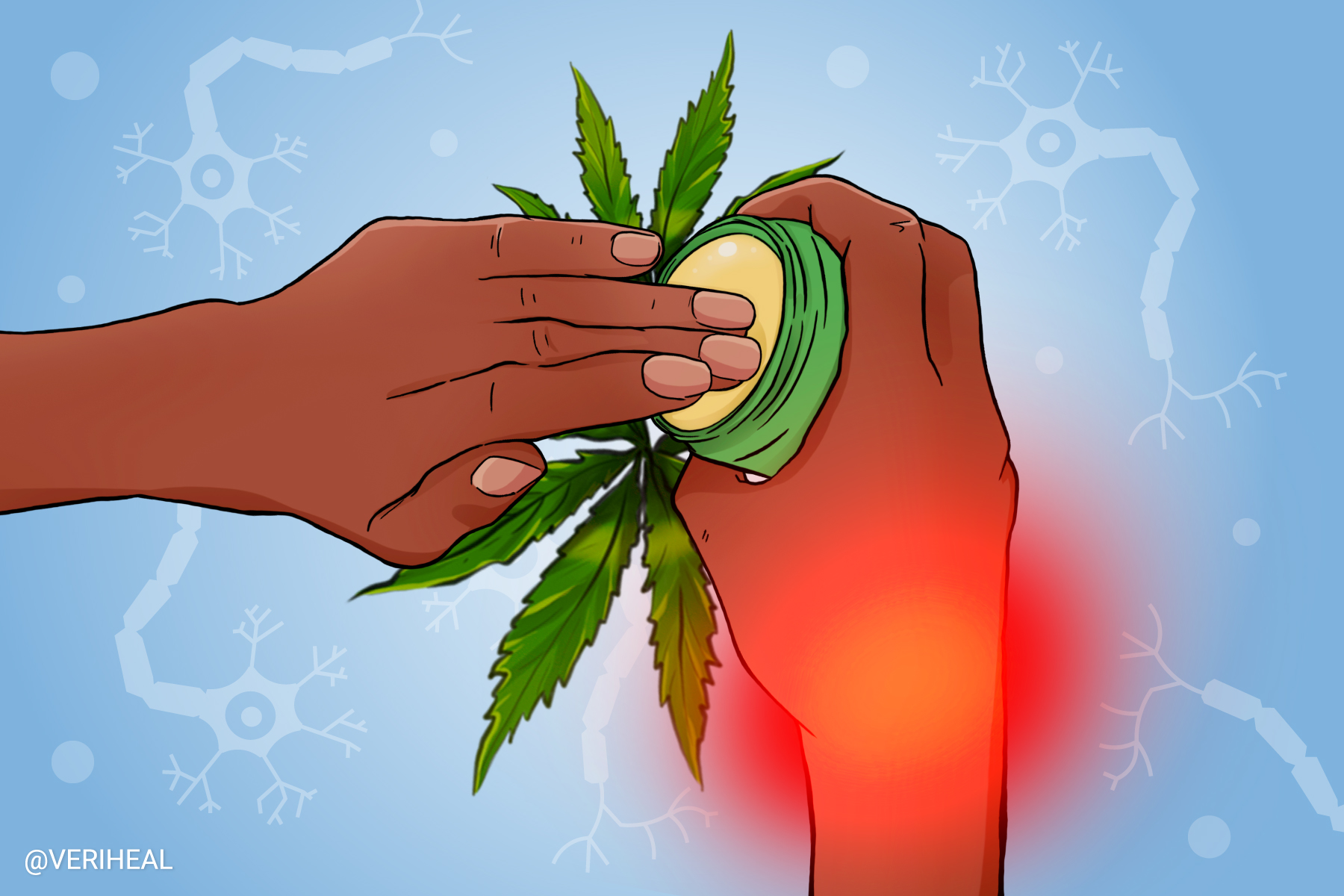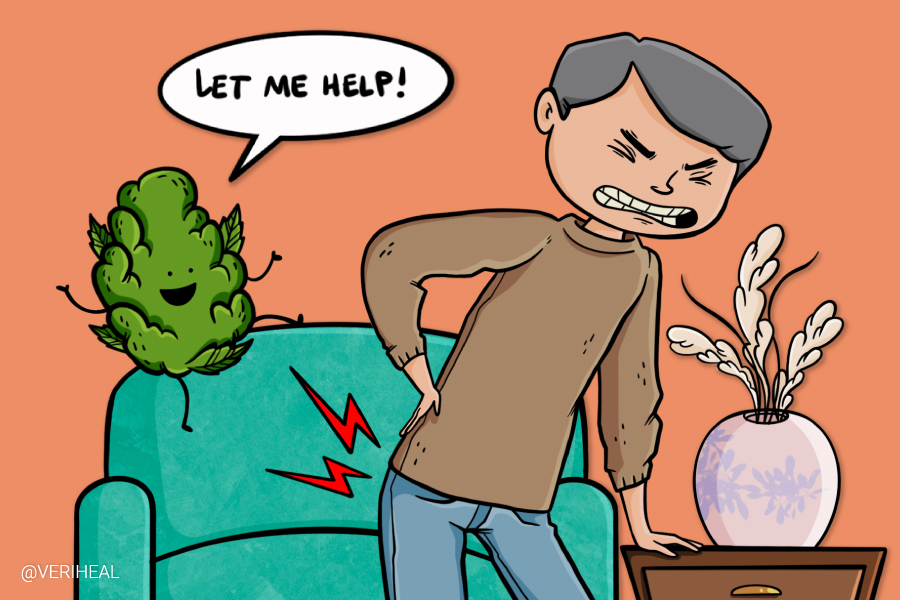Patients with Shingles Are Turning to Medical Marijuana for Pain Relief

What You Need to Know: Cannabis for Shingles
While research on cannabis’s direct effects on shingles is limited, anecdotal evidence suggests it may alleviate symptoms like pain, inflammation, and itching. Cannabis contains cannabinoids that interact with the body’s endocannabinoid system (ECS), potentially reducing itching and inflammation by targeting cannabinoid receptors and transient receptor potential (TRP) receptors in the skin.
Research also suggests that cannabinoids may modulate the immune system and possess antiviral properties, although direct evidence in the context of shingles is lacking. Neuropathic pain is a common symptom of shingles, and cannabis has shown promise in reducing such pain through its interaction with cannabinoid receptors, although research results on cannabis for chronic pain and neuropathy are mixed.
Despite some positive findings, research on cannabis for shingles and postherpetic neuralgia (PHN) remains inconclusive, and patients considering cannabis should consult their physician due to potential interactions with medications and underlying health conditions. Overall, while medical cannabis shows promise in managing shingles symptoms, further research is needed to fully understand its efficacy and safety for this condition.
The Science Behind Cannabis for Shingles:
- Targeting Shingles Through the Skin
- Cannabis for Neuropathic Pain in Shingles
- Risks for Developing Shingles
- Complications of Shingles
Shingles is a very painful, burning rash that results from viral nerve pain. Patients who get shingles typically have already had chickenpox (varicella-zoster virus) or have been vaccinated for it. It typically lasts a few weeks, and many patients can suffer from nerve pain or neuropathy for months to years after the infection goes away. Thankfully medical cannabis has been shown to serve as an antiviral for other forms of the herpes virus and it can help relieve inflammation, chronic pain, and help heal damaged skin.
Cannabis contains 100s of naturally occurring compounds including cannabinoids that can work with our body to help with several processes including how we perceive pain and modulating the immune system during infections or autoimmune diseases. Δ9-tetrahydrocannabinol (THC) and cannabidiol (CBD) are a few of these cannabinoids that interact with the body through the endocannabinoid system (ECS). The endocannabinoid system is a system in all our bodies that consists of fatty-based neurotransmitters that include anandamide (AEA) and 2-arachidonoylglycerol (2-AG). These endocannabinoids can be increased or decreased in our bodies and serve a variety of medical purposes after cannabinoids have made contact through cannabinoid receptors CB1 and CB2, as well as transient receptor potential (TRP) receptors.
Targeting Shingles Through the Skin
Fortunately, the ECS functions in several parts of our bodies including the skin. The skin contains large amounts of cannabinoid receptors as well as AEA in keratinocytes (the primary skin cell), skin nerve fibers, hair follicles, sweat glands, and sebaceous (oil) glands (9). Because of the ECS presence in the skin, it is a great target for treating itching (pruritis), eczema, acne, epidermolysis bullosa, skin cancer, and more.
Many patients who are unfortunate enough to get shingles also deal with extreme pruritis or itching. Cannabinoids bind to fat and there are a lot of cannabinoid receptors in the skin as well as TRP receptors that both play a role in itching (1). Researchers focusing on itch regarding atopic dermatitis, a type of eczema, believe that TRP receptors serve as ionotropic cannabinoid receptors (9). This means that these receptors play a role in reducing pain in the nerves of the skin as well as reducing inflammation.
A study on atopic dermatitis utilized TRP receptors to reduce itch in a group of 2456 patients by applying a cream containing the endocannabinoid N-palmitoyl ethanolamine (PEA). Itching, scratching, scaling, redness, skin thickening, and dryness were reduced by 58.6% and over half of the patients were able to discontinue the use of corticosteroids which are standard treatment in eczema (10). Though PEA is not an endocannabinoid itself, rather it enhances endocannabinoid binding and shows that there is potential for itching and pain relief of the skin when it is upregulated by cannabis and endocannabinoids.
Along with this research, there have been several other studies showing positive results for the anti-inflammatory properties of cannabis topicals on the skin. Many of these positive benefits come from balms, creams, or salves that contain larger amounts of CBD as opposed to THC. These topical options may also relieve the itching associated with the shingles rash. Some patients also find that edibles are a good solution for shingles pain that often results in a burning sensation.
Medical Cannabis as an Antiviral
There is a lot of research that supports that cannabis can modulate the immune system and affect the functionality of immune cells such as cytokines and lymphocytes because cannabinoid receptors can be found in immune cells (31). For more information on how this works check out our pages on inflammation and autoimmune diseases. The cannabis plant can also serve as an antimicrobial agent as seen on our sepsis page.
There is also potential for using medical marijuana to help combat viruses through modulating the immune system in similar pathways as seen above. However, there isn’t yet any direct evidence of cannabinoids serving as antivirals.
A 2020 review from Cannabis and Cannabinoid Research took to the task of reviewing whether CBD can play a role in fighting viruses. The studies reviewed focused on viral hepatitis C as well as Kaposi sarcoma (KSHV), a viral manifestation of skin cancer (31). This review shows that though there is a lack of research on CBD and other cannabinoids being used again viruses such as herpes simplex, medical cannabis still has the potential to help through its phytochemicals including flavonoids & terpenes. There is some evidence that THC, on the other hand, could make viral infections like KSHV and herpes simplex virus (HSV) worse in some patients.
Terpenes are organic compounds found in plants that are known for producing fragrances (think essential oils) and have medicinal properties. Flavonoids are like terpenes in that they contribute to the aromas of cannabis and other plants, but they tend to have their own medicinal properties (20). Flavonoids have been shown to have moderate antiviral activity against both herpes simplex 1 and herpes simplex 2 (23) (20). There are several other studies talking about similar effects of flavonoids on viral targets, especially herpes simplex viruses. This is of note to patients with chickenpox or shingles because the varicella-zoster virus, the virus that causes these infections, is a type of herpes virus (16).
Further research is needed to investigate the potential antiviral activity of flavonoids, terpenes, cannabinoids and figure out what molecules, combinations, or dosages could be effective in humans against herpes-type viruses like varicella-zoster, if any.
Cannabis for Neuropathic Pain in Shingles
There is also a significant research base about cannabis products and the reduction of neuropathic pain. Neuropathic pain, or neuropathy, is pain, tingling, burning, or numbness that is caused by damage or an infection that affects the nerves. Shingles fall into this category as it can lead to a chronic neuropathic condition called postherpetic neuralgia (PHN). Unfortunately, many patients with PHN do not benefit from traditional medications including non-steroidal anti-inflammatory drugs (NSAIDs), antidepressants, or antileptics such as gabapentin as they have breakthrough pain (19).
Cannabis has been shown to be able to alter how we perceive pain as well as lower inflammation through the activation of CB1 receptors in the frontal lobe of the brain and CB2 receptors in other areas of the body (19). The difficult part of evaluating all this research regarding chronic pain and neuropathy is that these studies often have mixed results and do not always show consistent results. Please check out our pages on neuropathy and chronic pain for more guidance on this and how medical cannabis can benefit help patients with PHN.
Thoughts about Cannabinoids and Shingles
It is important to note that a lot of the research regarding cannabis use, shingles, and PHN still show very mixed results. Thus, cannabis use for these conditions is not recommended at this time. Despite this, if you decide to use cannabinoids for shingles it is important to reach out to the physician that is treating your shingles before beginning treatments. Medical cannabis can interfere with certain medications, including epilepsy medications that are often used to treat nerve pain. Patients with existing heart conditions may put themselves at risk for tachycardia while using cannabis.
Another important thought to consider is that though there is a lot of research showing positive results concerning the use of medical cannabis for skin conditions, this research is still in its infancy and cannot be fully recommended by dermatologists at this time.
Risks for Developing Shingles
Anyone who has previously had the chickenpox virus or even been vaccinated for shingles may be at risk of developing it. Patients also have an increased risk for developing shingles if they (28):
- Are over the age of 50
- Are taking immunosuppressive drugs
- Had a recent organ transplant
- Have any of the following immunosuppressive conditions:
- HIV/AIDs
- Asthma
- Allergies
- Autoimmune Diseases
Complications of Shingles
Most people can fully recover, but some patients can have long-term complications and symptoms of shingles. Some of these complications include (28):
- Vision loss – this can occur if shingles affects your eyes. It can be temporary or permanent
- Hearing or balance issues – can happen if shingles occur in or near your ear. It can also be temporary or permanent
- Face muscle weakness – this can happen if shingles occur on your face. It can be temporary or permanent
- Pneumonia
- Encephalitis or brain inflammation
- Postherpetic neuralgia (PHN)
What is Postherpetic Neuralgia (PHN)?
PHN is a type of long-term nerve pain of the skin that can occur in patients who have recently had shingles. The nerve pain occurs in areas of the body that had been affected by the rash from shingles (7). This happens because the herpes zoster virus had physically damaged the nerves in patients with PHN (8).
Unfortunately for patients who experience PHN, the pain can last for months or years after shingles have gone away. This pain can be extremely painful and interfere with daily activities. It is usually seen as a burning nerve pain that typically only occurs on one side of the body, but some patients may experience it on both sides of the body or may experience sharp-stabbing pains (8). These patients may also have allodynia, a type of neuropathy that causes the skin to hurt when touched by fabrics or lightly touched.
Note: Veriheal does not intend to give this as professional medical advice. Do not attempt to self-diagnose or prescribe treatment based on the information provided on this page. Always consult a physician before making any decision on the treatment of a medical condition.
1. Baswan, S. M., Klosner, A. E., Glynn, K., Rajgopal, A., Malik, K., Yim, S., & Stern, N. (2020). Therapeutic Potential of Cannabidiol (CBD) for Skin Health and Disorders. Clinical, cosmetic and investigational dermatology, 13, 927–942. https://www.ncbi.nlm.nih.gov/pmc/articles/PMC7736837/
2. Bautista, J. L., Yu, S., & Tian, L. (2021). Flavonoids in Cannabis sativa: Biosynthesis, Bioactivities, and Biotechnology. ACS omega, 6(8), 5119–5123. https://www.ncbi.nlm.nih.gov/pmc/articles/PMC7931196/
3. Boychuk, D. G., Goddard, G., Mauro, G., & Orellana, M. F. (2015). The effectiveness of cannabinoids in the management of chronic nonmalignant neuropathic pain: a systematic review. Journal of oral & facial pain and headache, 29(1), 7–14. https://pubmed.ncbi.nlm.nih.gov/25635955/
4. Burstein S. (2015). Cannabidiol (CBD) and its analogs: a review of their effects on inflammation. Bioorganic & medicinal chemistry, 23(7), 1377–1385. https://pubmed.ncbi.nlm.nih.gov/25703248/
5. Carr, D. J., & Tomanek, L. (2006). Herpes simplex virus and the chemokines that mediate the inflammation. Current topics in microbiology and immunology, 303, 47–65. https://www.ncbi.nlm.nih.gov/pmc/articles/PMC4076168/
6. Caterina, M. J., & Pang, Z. (2016). TRP Channels in Skin Biology and Pathophysiology. Pharmaceuticals (Basel, Switzerland), 9(4), 77. https://www.ncbi.nlm.nih.gov/pmc/articles/PMC5198052/
7. Centers for Disease Control and Prevention. (2019, July 1). Complications of shingles (herpes zoster). Centers for Disease Control and Prevention. Retrieved January 14, 2022, from https://www.cdc.gov/shingles/about/complications.html
8. DermNet NZ. (n.d.). Post-herpetic neuralgia. Retrieved January 14, 2022, from https://dermnetnz.org/topics/post-herpetic-neuralgia
9. Eagleston, L. R., Kalani, N. K., Patel, R. R., Flaten, H. K., Dunnick, C. A., & Dellavalle, R. P. (2018). Cannabinoids in dermatology: A scoping review. Dermatology Online Journal, 24(6). https://escholarship.org/uc/item/7pn8c0sb
10. Eberlein, B., Eicke, C., Reinhardt, H. W., & Ring, J. (2008). Adjuvant treatment of atopic eczema: assessment of an emollient containing N-palmitoylethanolamine (ATOPA study). Journal of the European Academy of Dermatology and Venereology : JEADV, 22(1), 73–82. https://pubmed.ncbi.nlm.nih.gov/18181976/
11. Ellis, R. J., Toperoff, W., Vaida, F., van den Brande, G., Gonzales, J., Gouaux, B., Bentley, H., & Atkinson, J. H. (2009). Smoked medicinal cannabis for neuropathic pain in HIV: a randomized, crossover clinical trial. Neuropsychopharmacology : official publication of the American College of Neuropsychopharmacology, 34(3), 672–680. https://www.ncbi.nlm.nih.gov/pmc/articles/PMC3066045/
12. European Medicines Agency. (2007, January 24). GUIDELINE ON CLINICAL MEDICINAL PRODUCTS INTENDED FOR THE TREATMENT OF NEUROPATHIC PAIN. https://www.ema.europa.eu/en/documents/scientific-guideline/guideline-clinical-medicinal-products-intended-treatment-neuropathic-pain_en.pdf
13. Fischer-Stenger, K., Updegrove, A. W., & Cabral, G. A. (1992). Delta 9-tetrahydrocannabinol decreases cytotoxic T lymphocyte activity to herpes simplex virus type 1-infected cells. Proceedings of the Society for Experimental Biology and Medicine. Society for Experimental Biology and Medicine (New York, N.Y.), 200(3), 422–430. https://pubmed.ncbi.nlm.nih.gov/1319584/
14. Guindon, J., & Hohmann, A. G. (2009). The endocannabinoid system and pain. CNS & neurological disorders drug targets, 8(6), 403–421. https://www.ncbi.nlm.nih.gov/pmc/articles/PMC2834283/
15. Hall, G. C., Carroll, D., & McQuay, H. J. (2008). Primary care incidence and treatment of four neuropathic pain conditions: a descriptive study, 2002-2005. BMC family practice, 9, 26. https://www.ncbi.nlm.nih.gov/pmc/articles/PMC2413228/
16. Kennedy, P. G., Rovnak, J., Badani, H., & Cohrs, R. J. (2015). A comparison of herpes simplex virus type 1 and varicella-zoster virus latency and reactivation. The Journal of general virology, 96(Pt 7), 1581–1602. https://www.ncbi.nlm.nih.gov/pmc/articles/PMC4635449/
17. Koppel, B. S., Brust, J. C., Fife, T., Bronstein, J., Youssof, S., Gronseth, G., & Gloss, D. (2014). Systematic review: efficacy and safety of medical marijuana in selected neurologic disorders: report of the Guideline Development Subcommittee of the American Academy of Neurology. Neurology, 82(17), 1556–1563. https://www.ncbi.nlm.nih.gov/pmc/articles/PMC4011465/
18. Mabou Tagne, A., Pacchetti, B., Sodergren, M., Cosentino, M., & Marino, F. (2020). Cannabidiol for Viral Diseases: Hype or Hope?. Cannabis and cannabinoid research, 5(2), 121–131. https://www.liebertpub.com/doi/10.1089/can.2019.0060
19. Mücke, M., Phillips, T., Radbruch, L., Petzke, F., & Häuser, W. (2018). Cannabis-based medicines for chronic neuropathic pain in adults. The Cochrane database of systematic reviews, 3(3), CD012182. https://www.ncbi.nlm.nih.gov/pmc/articles/PMC6494210/
20. Naithani R, Mehta RG, Shukla D, et al. Antiviral activity of phytochemicals: a current perspective. In: Watson RZibadi SPreedy V, eds. Dietary components and immune function. Humana Press: Totowa, NJ, 2010, pp. 421–468. https://www.ncbi.nlm.nih.gov/pmc/articles/PMC7121922/
21. Nattkemper, L. A., Tey, H. L., Valdes-Rodriguez, R., Lee, H., Mollanazar, N. K., Albornoz, C., Sanders, K. M., & Yosipovitch, G. (2018). The Genetics of Chronic Itch: Gene Expression in the Skin of Patients with Atopic Dermatitis and Psoriasis with Severe Itch. The Journal of investigative dermatology, 138(6), 1311–1317. https://www.jidonline.org/article/S0022-202X(18)30004-6/fulltext
22. Nurmikko, T. J., Serpell, M. G., Hoggart, B., Toomey, P. J., Morlion, B. J., & Haines, D. (2007). Sativex successfully treats neuropathic pain characterised by allodynia: a randomised, double-blind, placebo-controlled clinical trial. Pain, 133(1-3), 210–220. https://pubmed.ncbi.nlm.nih.gov/17997224/
23. Phrutivorapongkul, A., Lipipun, V., Ruangrungsi, N., Kirtikara, K., Nishikawa, K., Maruyama, S., Watanabe, T., & Ishikawa, T. (2003). Studies on the chemical constituents of stem bark of Millettia leucantha: isolation of new chalcones with cytotoxic, anti-herpes simplex virus and anti-inflammatory activities. Chemical & pharmaceutical bulletin, 51(2), 187–190. https://www.jstage.jst.go.jp/article/cpb/51/2/51_2_187/_article
24. Scott, F. T., Johnson, R. W., Leedham-Green, M., Davies, E., Edmunds, W. J., & Breuer, J. (2006). The burden of Herpes Zoster: a prospective population based study. Vaccine, 24(9), 1308–1314. https://pubmed.ncbi.nlm.nih.gov/16352376/
25. Tahamtan, A., Tavakoli-Yaraki, M., Rygiel, T. P., Mokhtari-Azad, T., & Salimi, V. (2016). Effects of cannabinoids and their receptors on viral infections. Journal of medical virology, 88(1), 1–12. https://pubmed.ncbi.nlm.nih.gov/26059175/
26. Tóth, K., Ádám, D., Bíró, T., & Oláh, A. (2019). Cannabinoid signaling in the skin: Therapeutic potential of the “c(ut)annabinoid” system. Molecules,24(5), 918. https://www.mdpi.com/1420-3049/24/5/918/htm
27. Tyring S. K. (2007). Management of herpes zoster and postherpetic neuralgia. Journal of the American Academy of Dermatology, 57(6 Suppl), S136–S142. https://pubmed.ncbi.nlm.nih.gov/18021865/
28. U.S. National Library of Medicine. (2021, September 29). Shingles | herpes zoster. MedlinePlus. Retrieved January 14, 2022, from https://medlineplus.gov/shingles.html
29. Wilsey, B., Marcotte, T., Deutsch, R., Gouaux, B., Sakai, S., & Donaghe, H. (2013). Low-dose vaporized cannabis significantly improves neuropathic pain. The journal of pain, 14(2), 136–148. https://www.ncbi.nlm.nih.gov/pmc/articles/PMC3566631/
30. Zhang, H., Yang, Y., Cui, J., & Zhang, Y. (2012). Gaining a comprehensive understanding of pruritus. Indian journal of dermatology, venereology and leprology, 78(5), 532–544. https://ijdvl.com/gaining-a-comprehensive-understanding-of-pruritus/
31. Mabou Tagne, A., Pacchetti, B., Sodergren, M., Cosentino, M., & Marino, F. (2020). Cannabidiol for viral diseases: Hype or hope? Cannabis and Cannabinoid Research, 5(2), 121–131. https://www.liebertpub.com/doi/10.1089/can.2019.0060








